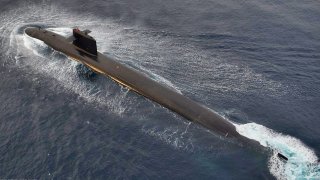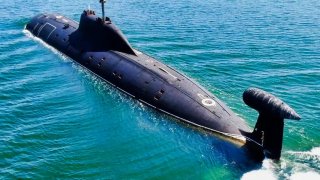
January 2, 2024
The French Navy (Marine Nationale) and their four Le Triomphant-class ballistic missile submarines (SSBNs) are the most expensive subs on the planet today. What they could do in a war explains why.
While the Seawolf-Class nuclear attack submarine is indeed the most expensive in American naval history, it is surprisingly not the most expensive submarine in the world. That distinction instead belongs to the French Navy (Marine Nationale) and their four Le Triomphant-class ballistic missile submarines (SSBNs).
From L’Arc de Triomphe to Les Sous-marins de Triomphant
France’s claim over the world’s most expensive submarine may come as a surprise to some, in light of former POTUS Donald Trump’s criticism of the dearth of defense expenditures on the part of the European NATO members. As of 2020, France spent the equivalent of $52,47 billion on defense, which equates to a 2.07% share of GDP. Evidently, however, the French government doesn’t mind spending more on submarines.
Just how expensive are the Triomphant-class boats, or the SNLE-NG (Sous-Marins Nucleaires Lanceurs Engins-Nouvelle Generation/Next Generation Device-Launching Nuclear Submarine)?
The Federation of American Scientists provides these mind-boggling numbers:
“Constructing the fourth SNLE cost 13 billion francs, and avoided a drawdown in deployments. Of the submarines currently in the strategic submarine force (FOST), four are always operational and two are at sea. With four SNLEs, three could be operational at any given time. The SNLE-NG program is estimated to cost 88.4 billion francs for four submarines. The average cost per submarine has increased from 10 billion francs in 1986 to 12.5 billion.”
To translate that into today’s monetary figures, we turn to FXTOP’s handy foreign currency inflation calculator, which shows that if the French Franc still existed today instead of the Euro, 12.5 billion francs in 1986 would be the equivalent of 23.66 billion francs today, which in turn would equate to $3.49 billion.
To put that in further perspective, the average cost of a Seawolf is an even $3 billion, its 22 Virginia-class successors built so far have averaged out to a unit cost of $2.8 billion, and the time-honored Los Angeles-class SSNs price out to a downright frugal $1.6 billion per boat.
More Bang for the Buck?
So then, just what sort of value does the Marine Nationale get for these successors to the 1967 vintage Redoutable-class submarines?
As per the Seaforcesorg info page, “They provide the ocean-based component (the Force océanique stratégique) of France's nuclear deterrent strike force, the Force de Frappe. This class reportedly produces approximately 1/1000 of the detectable noise of the Redoutable-class SSBN's, and they are ten times more sensitive in detecting other submarines.”
The four ships of the class are the FS Le Triomphant (S 616), FS Le Téméraire (S 617), FS Le Vigilant (S 618), and FS Le Terrible (S 619). They were commissioned between 1997 and 2010. These vessels sport a hull length of 138 meters, a beam width of 12.5 meters, and a draught of 10.6 meters. Displacement is 12,640 tons on the surface and 14,335 tons while submerged, with a top submerged speed of 25+ knots. Test depth is reportedly over 400 meters.
Armament-wise, these warships pack one hellacious punch: They carry 16 Vertical Launch Tubes designed initially for the M45, and later for the M51 submarine-launched ballistic missiles (SLBMs). The latter missile carries between four and six multiple independently targetable reentry vehicles (MIRVs); each of these MIRVs has a nuclear yield of 150 kilotons. Meanwhile, for more conventional naval warfighting, these undersea behemoths wield four 533mm (21-inch) torpedo tubes capable of firing either F17 Mod. 2 heavyweight torpedoes or MBDA Exocet SM39 anti-ship missiles.
The Future of the Triomphant Class?
The French Navy has already announced a replacement project for the Triomphant boats: the SNLE-3G-class, Sous-Marin Nucléaire Lanceur d'Engins de 3rd Génération, which is projected to enter service around the year 2032.
According to submarine expert Mr. H.I. Sutton, the future subs will exceed the size of the Triomphant by 6 to 10 meters in length and about 2,000 tons in displacement. Four ships of the line are planned, ergo a one-for-one replacement.
As for costs, some experts project a price tag of nearly 40 billion Euros ($38.77 billion). But of course, much like preseason projections of American football college bowl game matchups, these predictions fall into the “way too early” category. Ten years is an absolute eternity when it comes to weapon systems design and procurement.
In the meantime, the French people can count on Le Triomphant and her sister ships to defend their shores for quite a few years to come. Vive la France.
About the Author
Christian D. Orr is a former Air Force Security Forces officer, Federal law enforcement officer, and private military contractor (with assignments worked in Iraq, the United Arab Emirates, Kosovo, Japan, Germany, and the Pentagon). Chris holds a B.A. in International Relations from the University of Southern California (USC) and an M.A. in Intelligence Studies (concentration in Terrorism Studies) from American Military University (AMU). He has also been published in The Daily Torch and The Journal of Intelligence and Cyber Security. Last but not least, he is a Companion of the Order of the Naval Order of the United States (NOUS).
LA REVUE GAUCHE - Left Comment: Search results for PERMANENT ARMS ECONOMY
Russia's Sierra-Class II Titanium Submarines Are a Giant Mystery
The Soviet Union didn't build additional Sierra II-Class or what is also called Project 945A Kondor Class submarines due to the high cost of the materials, and the difficulties in working with titanium.
by Peter Suciu
The first boats to be built in the Soviet Union were little more than improved editions of those built prior to the First World War, and that trend continued until the 1950s – when the Kremlin sought to counter the submarine capabilities of the West.
In the 1960s, the Soviet Union developed the Project 661 "Anchar" (NATO reporting name "Papa-Class"), a nuclear-powered cruise-missile submarine that was upon completion the world's fastest submarine. It was also the first to be built with a titanium hull. While fast, it was noisy; and it was soon determined that its flaws outweighed its advantages. However, it pioneered the technology needed to work with titanium on a large scale, which enabled the subsequent construction of more successful designs using titanium
This led to the development of more advanced submarines – notably Project 945 Barrakuda and Project 945A Kondor, (NATO reporting names Sierra I and Sierra II respectively). These boats were distinct for their titanium hulls, which allowed the submarines to dive to greater depths while reducing the emission of radiated noise and increasing resistance to torpedo attacks.
Sierra II-Class: Enter the Project 945A Kondor
The Sierra II Class, also known as Project 945A Kondor Class, remains among the Russian Navy's most expensive and deep-diving submarines. The boats were specifically developed for search and destroy missions against U.S. nuclear-powered ballistic missile submarines.
A follow-up to the Sierra I, the class was unique due to its light and strong titanium twin-pressure hulls, which featured space in between. That enabled the boats to dive to greater depths, while it reduced the level of radiated noise and increased resistance to torpedo attacks. Like the original Project 945 Barrakuda, the Project 945A boats were powered by a single OK-650 pressurized water reactor, rated at 190 MW.
It had greater speed and diving depth than its American counterparts at the time it was designed and would have been a serious threat if the Cold War turned hot. Two of the submarines were completed – the Pskov (ex-Zubatka) and Nizhny Novgorod (ex-Okun) – and both remain operational with the Russian Navy's Northern Fleet. A third of the class, Mars, was laid down in 1990. That boat was built to an improved Project 945B (NATO designation Sierra III class), but it was scrapped before completion in 1992.
Was the Sierra II-Class a Failure for Russia?
The Soviet Union didn't build additional Sierra II-Class or what is also called Project 945A Kondor Class submarines due to the high cost of the materials, and the difficulties in working with titanium.
As previously reported, to successfully weld huge titanium panels on a large scale, Soviet engineers had to first create enormous warehouses that were hermetically sealed and then filled with argon, an inert gas that would not interfere with the welding process. Welders had to wear a large cosmonaut-like suit that would supply them with oxygen while inside these warehouses.
Titanium is also rare and costly compared to iron, while it isn't exactly easy to shape either. Any misstep by the welders would create a sub that would be dangerous to take on deep dives. The higher pressure could compromise the weakened hull.
No News – Good News?
While Moscow regularly touts the capabilities of its military vessels, there has been surprisingly little said of the two Project 945A Kondor Class submarines in recent years
A November 2019 report from state media outlet Tass noted that the Nizhny Novgorod and Pskov held an underwater duel with torpedo practice fire in drills.
"The crews of the Northern Fleet's multipurpose nuclear-powered submarines Nizhny Novgorod and Pskov performed planned assignments in the Barents Sea… Torpedo practice fire against surface targets was the most complex and responsible stage of the joint underwater maneuvers. The crews of the Northern Fleet's multipurpose nuclear-powered submarines Nizhny Novgorod and Pskov performed this exercise in the duel version," the press office of the Russian Navy's Northern Fleet announced in a statement.
The submariners further were reported to have practiced combat maneuvering with their switchover to an attacking position and breaking from the enemy force by way of jamming and setting up dummy targets, according to the statement.

However, in the more than four years that followed there has been virtually no mention of the boats – and while they officially remain in service, it is believed both rarely leave port.
Author Experience and Expertise
Peter Suciu is a Michigan-based writer. He has contributed to more than four dozen magazines, newspapers, and websites with over 3,200 published pieces over a twenty-year career in journalism. He regularly writes about military hardware, firearms history, cybersecurity, politics, and international affairs. Peter is also a Contributing Writer for Forbes and Clearance Jobs. You can follow him on Twitter: @PeterSuciu.
Main image is a generic picture of a Russian Submarine that is Creative Commons. The intext image is also Creative Commons but of an actual Sierra-Class subm
No comments:
Post a Comment